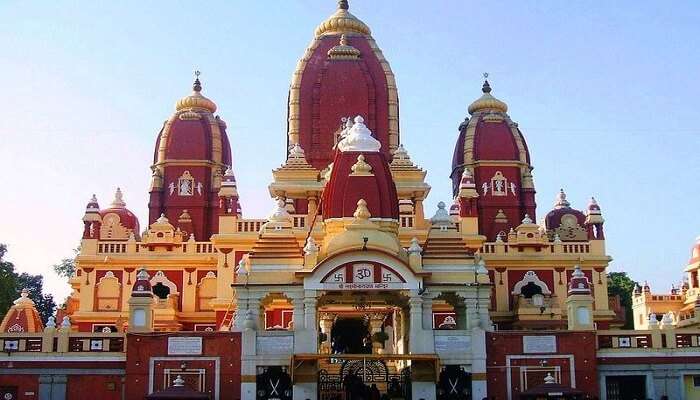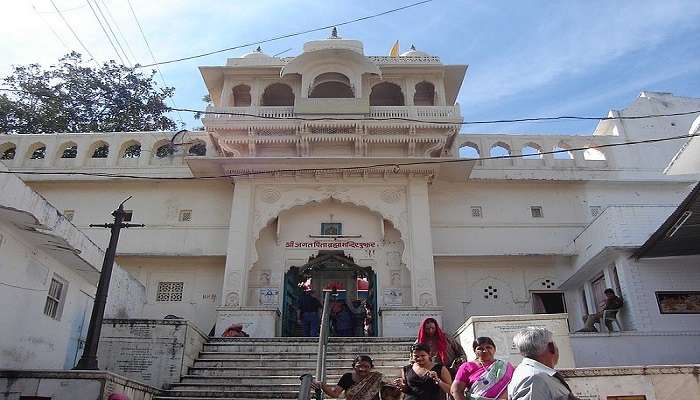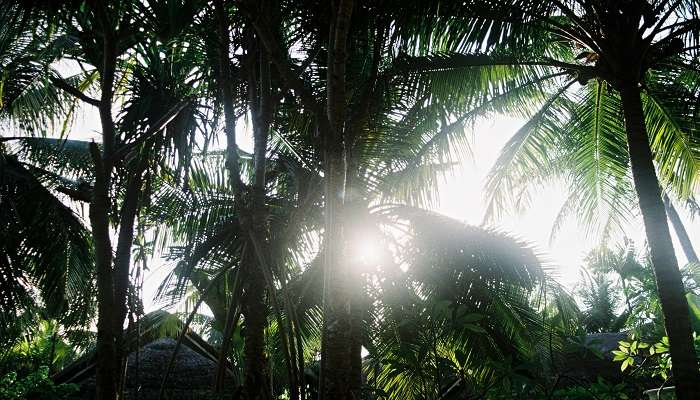Jambukeswarar Temple: A Sacred Abode In Tamil Nadu
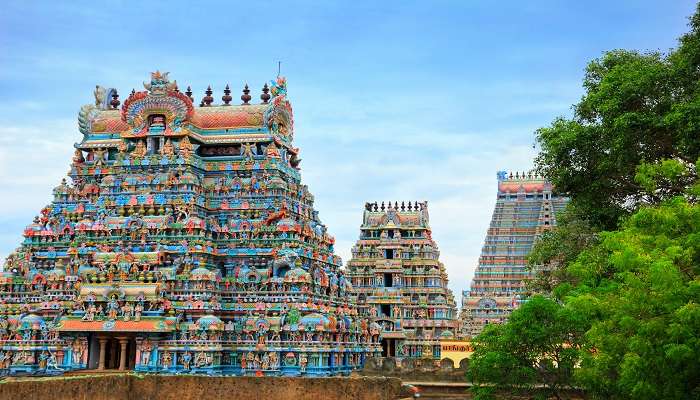
Towering over the historic city of Tiruchirapalli (Trichy) in Tamil Nadu, the Jambukeswarar temple is an awe-inspiring architectural wonder and a spiritual place. Dating back to the 7th century CE, this ancient Hindu temple complex is one of the most illustrious Shiva temples in South India. With its imposing gateway towers decorated with detailed carvings, vast pillared halls, and the sacred shrines sheltering the known lingams, it is a breathtaking incarnation of Dravidian architecture. From the melodic chanting of mantras to the fragrance of incense and flower offerings, every aspect of this temple resonates with the divine essence of Lord Shiva, the presiding deity.
Jambukeswarar Temple: An Overview
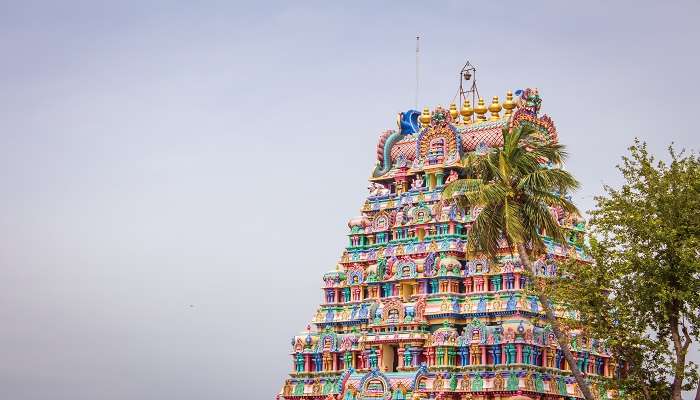
Jambukeswarar temple, also known as Thiruvanaikaval or Jambukeswaram, is a Shiva temple. Built by the Chola dynasty around 1,800 years ago, it is a testament to South Indian architecture. Its magnificent features include towering walls, expansive halls, and two large pyramidal towers called gopurams. Inside the temple, you will find five courtyards, each adorned with intricate details. Legends surround this sacred place, including the story of Akilandeswari, who conducted her penance here, creating a lingam out of the waters of the Cauvery River. This Appu Lingam continues to be revered by devotees. Additionally, the temple has inscriptions dating back to the Chola period and is part of the 275 Paadal Petra Sthalams.
Must Read: Temples In Tamil Nadu
History Of Jambukeswarar Temple
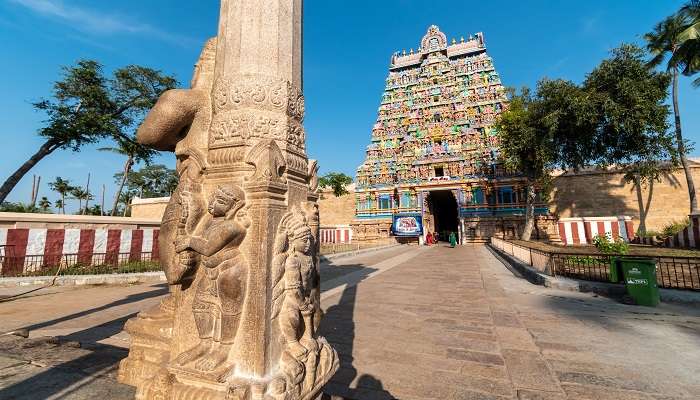
The Jambukeswarar temple’s origins trace back to the Chola dynasty, with King Kocengannan credited for its initial construction around the 2nd century CE. Among the five major Shiva temples of Tamil Nadu, The prominent legends associated with this sacred site are:
1. Parvati’s Penance
Parvati, assuming the form of Akilandeswari, undertook severe penance in the Jambu forest (Thiruvanaikoil) following Shiva’s instruction to descend to Earth from Kailasam. Utilising water from the Cauvery River (also known as River Ponni), she fashioned a lingam under the Venn Naaval tree. This unique Appu Lingam (Water Lingam) became the focal point of worship.
2. Elephant and Spider Devotion
Two Siva Ganas, Malyavan and Pushpadanta, fought in a Kailash dispute. Consequently, Malyavan cursed Pushpadanta to incarnate as an elephant on Earth, and Pushpadanta cursed Malyavan to become a spider. Both continued their worship of Siva at Thiruvanaikaval. The elephant fetched water from the Cauvery for ablution.
At the same time, the spider constructed a web over the lingam to shield it from falling leaves and harsh sunlight. Mistaking the web for dust, the elephant cleaned the lingam daily, angered the spider. In retaliation, the spider entered the elephant’s trunk and bit it, leading to their demise. Touched by their unwavering devotion, Shiva, assuming the form of Jambukeswara, liberated them from their curses.
Significance Of Jambukeswarar Temple
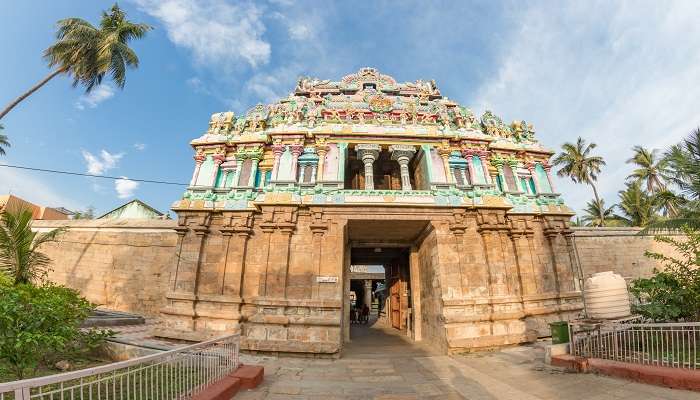
This ancient shrine holds immense significance, representing the water element among the five prominent Pancha Bhoota Sthalams, or the ‘Five Element Shrines,’ dedicated to Lord Shiva. The temple’s sanctum houses a unique subterranean stream that remains perpetually filled with water despite the authorities’ regular pumping efforts. Furthermore, this ever-flowing water is believed to emanate from the very lingam (representation) of Lord Jambukeswara, the temple’s presiding deity.
The Jambukeswarar temple is also among the revered 275 Paadal Petra Sthalams, holy sites praised in the Tevaram hymns. The verses of the four most honoured Nayanmars, the Saivite saint-poets, mention the 60th Shiva temple on the northern bank of the Cauvery River, further highlighting its historical significance. The main deity, Jambukeswara, is depicted as seated under a Jambu tree, with a small stream flowing over the lingam during the monsoon season. Moreover, legend has it that the deity’s clothes remain perpetually damp, reflecting the constant water flow from the lingam, which intensifies during the rainy season.
Suggested Read: Hill Stations In Tamil Nadu
Jambukeswarar Temple: Design, Structure, And Architecture
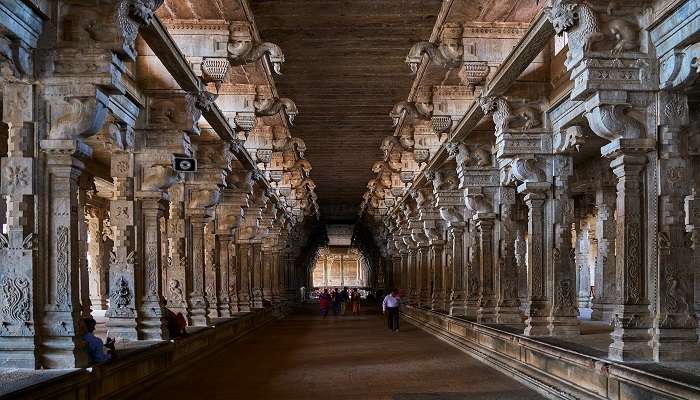
The Jambukeswarar temple is a sprawling testament to ancient Dravidian architecture. Dedicated to Lord Shiva, it’s not just a place of worship but a visual symphony in stone.
1. Design Significance

- Sanctum: The sanctum sanctorum is the place where the Shiva Lingam sits. The remarkable feature is that a natural underground stream constantly flows around the Lingam.
- Jambu Tree (Naval Fruit Tree): The temple’s name translates to “Lord of the Jambukeswaram,” referencing the presence of a large, revered Jambu tree within the complex. This tree holds immense significance as it’s believed to be the source of the underground stream nourishing the Lingam.
2. Structural Grandeur
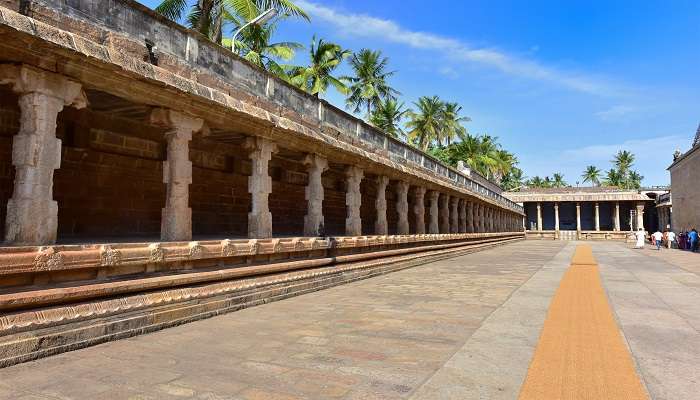
The temple structure is vast, with five enclosures progressively leading inwards to the sanctum.
- First Enclosure: Relatively small, housing 123 shrines.
- Second Enclosure: Larger, featuring a 65-foot tall gopuram (gateway tower) and several smaller shrines.
- Third Enclosure: Encompassing a significant area with a 39-foot high wall.
- Fourth Enclosure: The largest, containing 796 pillars and sprawling across a massive area.
- Fifth Enclosure (Vibhudi Prakara): This is the outermost layer, marked by a colossal outer wall over a mile long, two feet thick, and reaching over 25 feet in height.
3. Architectural Brilliance
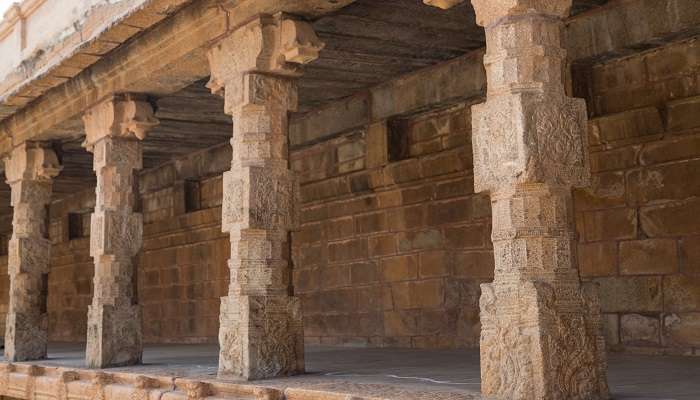
Dravidian architecture is the dominant style, characterised by:
- Gopurams: The temple boasts towering gopurams adorned with intricate carvings depicting mythological stories and deities.
- Mandapas (Halls): Several pillared halls grace the complex, each with a unique design and ornamentation.
- Sculptures and Reliefs: The pillars, walls, and ceilings are embellished with exquisite sculptures and detailed reliefs portraying religious narratives and temple history.
4. Additional Points Of Interest
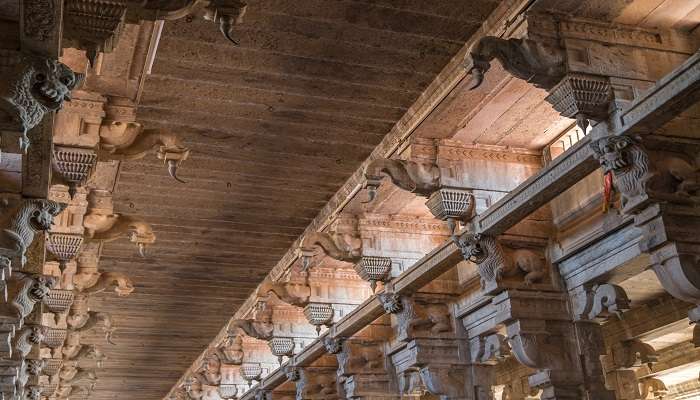
- Akhilandeswari Temple: Within the complex lies the Akilandeswari temple, dedicated to Goddess Parvati and considered the abode of the Goddess.
- Underground Water Passage: Legends speak of a hidden underground passage connecting the Jambukeswarar temple to the River Cauvery, further emphasising the water element.
Jambukeswarar Temple: Best Time To Visit
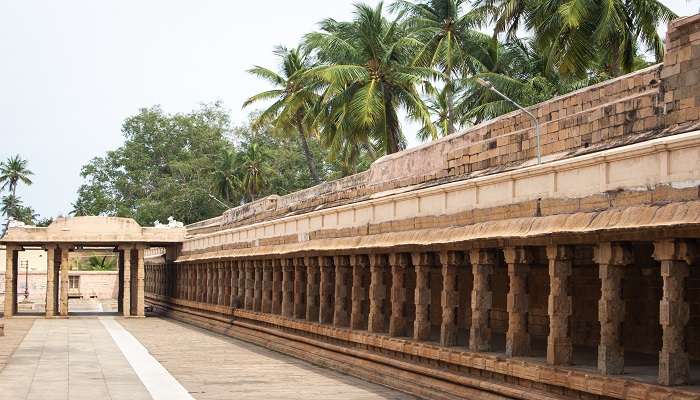
Deciding the best time to visit the Jambukeswarar Temple can greatly enhance the overall experience. Thus, the best time to visit the temple includes:
1. During Normal Days
During this period, the climate in Tiruchirappalli is pleasant, with moderate temperatures (between 19°C to 22°C).
2. During Festivals
If you’re looking to immerse yourself in the cultural and religious fervour of the place, consider visiting during the following festivals:
- Maha Shivaratri (February or March): A major festival dedicated to Lord Shiva, Maha Shivaratri witnesses grand celebrations at the temple.
- Panguni Brahmmotsavam (March-April): This ten-day festival celebrates the legend of Parvati performing penance to win Lord Shiva.
Suggested Read: Cafes In Chennai
How To Reach Jambukeswarar Temple?
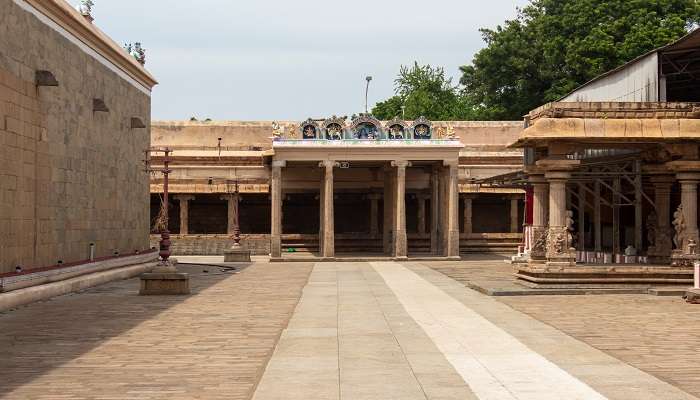
There are several easy ways to reach Jambukeswarar temple. They are:
By Air
Trichy Airport (Tiruchirapalli) is the closest airport, 15 Km from the temple. At the airport, you can find local transportation options to the temple.
By Train
Trichy Junction, the nearest railway station, is 8 Km from the temple. You can use local transport from there to reach the hotel easily.
By Road
The closest bus stand is Chathiram, located 3 Km from the temple. Public buses, autos, and taxis are readily available to take you there. The temple is conveniently situated on the Trichy-Chennai highway.
Jambukeswarar Temple Timings
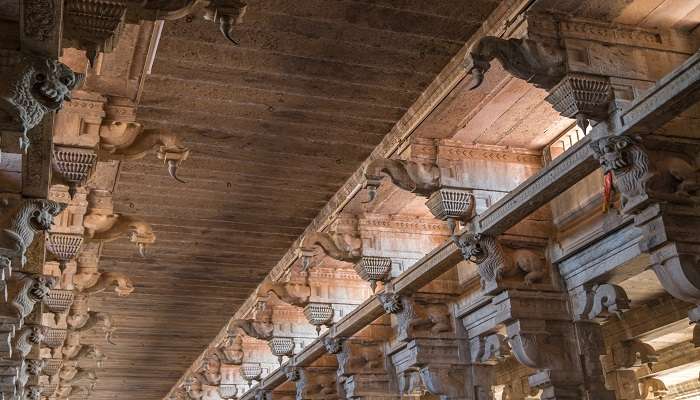
Going on a journey to Jambukeswarar temple promises a peaceful escape into spirituality. To plan your visit smoothly, you must check out when the temple opens and the timings for its prayer ceremonies. The Jambukeswarar temple timings are as follows:
1. Opening Timings
The Jambukeswarar temple opening time is generally two slots:
- Morning: 6:00 am to 12:00 pm
- Evening: 4:00 pm to 9:00 pm
2. Pooja Timings
The temple follows a specific schedule for darshan (holy viewing) and poojas (worship rituals) throughout the day.
- Alangaram (Decoration of the Deity): 7:00 am
- Kaala Santhi (Morning Prayer): 8:00 am
- Uchi Kaala Pooja (Noon Prayer): 12:00 noon
- Sayaratchai (Evening Prayer): 5:00 pm
3. Important Daily Pooja
One of the unique poojas performed at the temple is the noon pooja at the Akilandeswari Amman temple. A male priest dressed in a saree performs the pooja during this pooja. This pooja lasts for about 10 minutes and is held around 12:30 noon.
Suggested Read: Places To Visit In Chidambaram
Jambukeswarar Temple: Dress Code

There isn’t a strict dress code enforced at the Jambukeswarar temple. However, as a place of worship, dressing modestly is a sign of respect for the deities and traditions.
- Men: Opt for a dhoti, kurta, lungi, or pants with a shirt. Avoid shorts, sleeveless shirts, and overly revealing clothing.
- Women: Sarees, salwar kameez, or long skirts with kurtas are ideal. You can also wear a churidar with a dupatta (long scarf).
Jambukeswarar Temple: Things To Keep In Mind
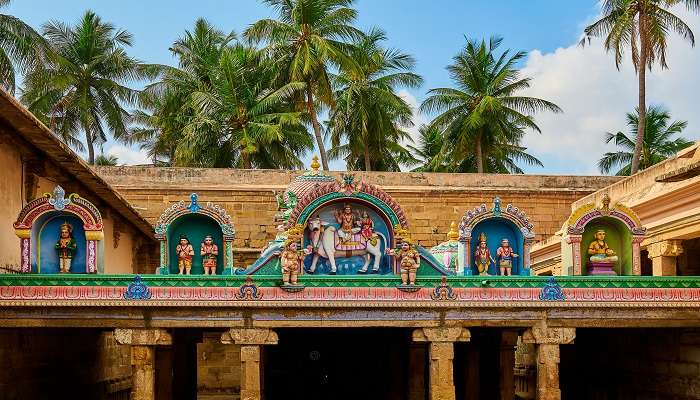
Some things to keep in mind when visiting the Jambukeswarar temple are:
-
- Dress code: As with most Hindu temples, visitors are expected to dress modestly. This means covering your shoulders and knees. You can also remove your footwear before entering the temple complex.
-
- Temple timings: The temple is typically open early in the morning and closes in the evening, with a break during the midday. You must adhere to the temple timings to avoid any problems.
-
- Photography: Photography is prohibited inside the sanctum sanctorum (the innermost part of the temple where the deity is housed). However, you can take photos in the outer courtyard and corridors of the temple.
-
- Offerings: You can purchase flowers, incense, and puja items from the shops outside the temple complex to offer to the deity.
-
- Guides: Guides are available for hire if you would like to learn more about the temple’s history and significance.
- Shoes: A shoe stand is available outside the temple where you can leave your footwear.
Further Read: Tourist Places In Hogenakkal
A jewel Jambukeswarar temple transcends time. Its architecture stuns the senses, whispering tales of a glorious past. Steeped in spiritual significance, the temple offers a profound experience, drawing you into the heart of Tamil Nadu’s rich culture. Ready to experience the wonders of Tiruchirapalli firsthand? Book your trip to Tamil Nadu now and start your journey of exploration and spirituality. Discover the beauty of this enchanting land for yourself!
For our editorial codes of conduct and copyright disclaimer, please click here.
Cover Image Source: Shutterstock
Frequently Asked Questions About Jambukeswarar Temple
What is special about Jambukeswarar temple?
Jambukeswarar is one of the five major Shiva temples in Tamil Nadu. Its unique feature is the sanctum sanctorum housing the Shiva lingam, partially submerged in underground water.
What is the dress code for Jambukeswarar temple?
As a place of worship, respectful attire is recommended. This means covering shoulders and knees for both men and women.
Who is the god of the water temple?
Lord Shiva is worshipped as Jambukeswarar in this temple, representing the element of water.
What is the history of Jambukeswaram?
The temple's history stretches back to the 2nd century BC, with renovations by various rulers over time. Legend associates it with Saint Adi Shankara and Parvati worshipping Shiva here.
How many years old is Jambukeswarar temple?
Jambukeswarar temple is estimated to be around 1800 years old, dating back to the Chola dynasty.
People Also Read:
Kartik Swami Temple Triyuginarayan Temple Meenakshi Temple

Experience the world through captivating stories of adventure and travel. As a senior content writer, I bring my passion for exploration to life, crafting tales that take you on a journey. With my words, you’ll feel the thrill of discovery and the joy of experiencing new cultures. Let me turn your imagination into a reality with stories that inspire you to explore and embrace the world.



